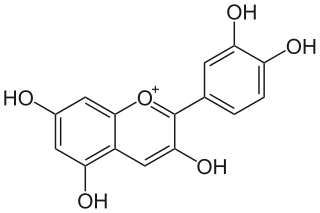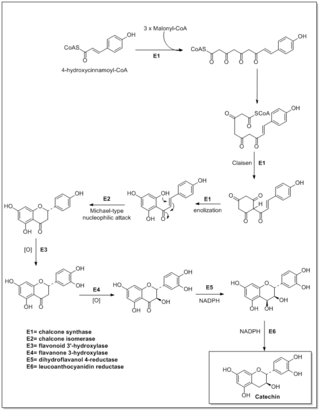
Cyanidin is a natural organic compound. It is a particular type of anthocyanidin. It is a pigment found in many red berries including grapes, bilberry, blackberry, blueberry, cherry, chokeberry, cranberry, elderberry, hawthorn, loganberry, açai berry and raspberry. It can also be found in other fruits such as apples and plums, and in red cabbage and red onion. It has a characteristic reddish-purple color, though this can change with pH; solutions of the compound are red at pH < 3, violet at pH 7-8, and blue at pH > 11. In certain fruits, the highest concentrations of cyanidin are found in the seeds and skin. Cyanidin has been found to be a potent sirtuin 6 (SIRT6) activator.

Flavonoids are synthesized by the phenylpropanoid metabolic pathway in which the amino acid phenylalanine is used to produce 4-coumaroyl-CoA. This can be combined with malonyl-CoA to yield the true backbone of flavonoids, a group of compounds called chalcones, which contain two phenyl rings. Conjugate ring-closure of chalcones results in the familiar form of flavonoids, the three-ringed structure of a flavone. The metabolic pathway continues through a series of enzymatic modifications to yield flavanones → dihydroflavonols → anthocyanins. Along this pathway, many products can be formed, including the flavonols, flavan-3-ols, proanthocyanidins (tannins) and a host of other various polyphenolics.
In enzymology, an anthocyanin 5-aromatic acyltransferase is an enzyme that catalyzes the chemical reaction
In enzymology, an anthocyanin 6"-O-malonyltransferase is an enzyme that catalyzes the chemical reaction
In enzymology, a D-tryptophan N-malonyltransferase (EC 2.3.1.112) is an enzyme that catalyzes the chemical reaction
In enzymology, a flavonol-3-O-beta-glucoside O-malonyltransferase is an enzyme that catalyzes the chemical reaction
In enzymology, an isoflavone-7-O-beta-glucoside 6"-O-malonyltransferase is an enzyme that catalyzes the chemical reaction
In enzymology, an anthocyanin 3'-O-beta-glucosyltransferase is an enzyme that catalyzes the chemical reaction

In enzymology, a flavonol 3-O-glucosyltransferase is an enzyme that catalyzes the chemical reaction

Gentiana triflora is a tall, flowering perennial plant in the genus Gentiana native to higher-elevation meadows and forests of China, Mongolia, Eastern Russia, Korea and Japan.
Malonyltransferase can refer to:

Tricin is a chemical compound. It is an O-methylated flavone, a type of flavonoid. It can be found in rice bran and sugarcane.

Biochanin A is an O-methylated isoflavone. It is a natural organic compound in the class of phytochemicals known as flavonoids. Biochanin A can be found in red clover in soy, in alfalfa sprouts, in peanuts, in chickpea and in other legumes.

Purple corn or purple maize is group of flint maize varieties originating in South America, descended from a common ancestral variety termed "kʼculli" in Quechua. It is most commonly grown in the Andes of Peru, Bolivia and Ecuador.

Antirrhinin is an anthocyanin. It is the 3-rutinoside of cyanidin.
The biosynthesis of phenylpropanoids involves a number of enzymes.

p-Coumaroylated anthocyanins are a type of anthocyanins with a p-coumaric acid unit linked with a sugar to an anthocyanidin aglycone. 3-(6-p-Coumaroyl)glucosides are found in grape and wine. Cyanidin-3-O-(di-p-coumarylglucoside)-5-glucoside is found in dark opal basil. Red leaves of Perilla frutescens also accumulate cyanidin 3-(6-O-p-coumaroyl-β-D-glucoside)-5-(6-O-malonyl-β-D-glucoside).
Delphinidin 3',5'-O-glucosyltransferase is an enzyme with systematic name UDP-glucose:delphinidin 3-O-(6-O-malonyl)-beta-D-glucoside 3'-O-glucosyltransferase. This enzyme catalyses the following chemical reaction
Cyanidin-3-O-glucoside 2-O-glucuronosyltransferase is an enzyme with systematic name UDP-D-glucuronate:cyanidin-3-O-beta-D-glucoside 2-O-beta-D-glucuronosyltransferase. This enzyme catalyses the following chemical reaction
Purple sweet potato color (PSPC) is a natural anthocyanin food coloring obtained from the sweet potato. Some cultivars, like the Ayamurasaki, released in Japan in 1995, are specially developed to have a higher anthocyanin content.









